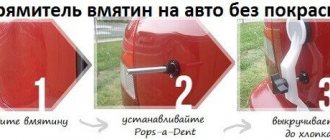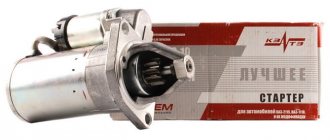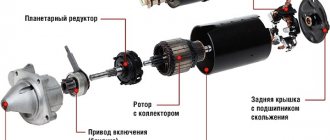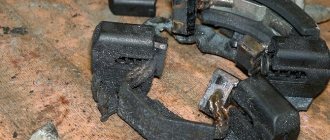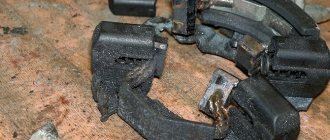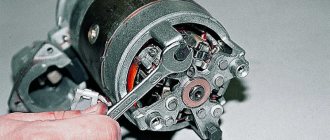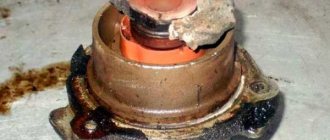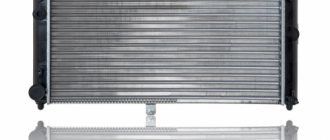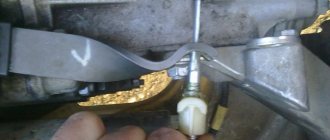Starter device
- A housing with a winding and four magnets is a stator.
- The rotating part is the rotor.
- The transmitter from the moving part to the engine flywheel is Bendix.
- The operating switch that starts the rotor when the ignition key is turned is a relay.
- An axis with a pressed core and collector plates is an anchor.
Starter device
The device is a DC motor with a two-winding relay and a power of 1.55 kW.
Do-it-yourself disassembly and repair
When you remove the starter, you need to disassemble it, otherwise you cannot repair it. To do this you need to follow this algorithm:
- Using a key set to “13”, unscrew the nut and release the solenoid relay from the wire.
- Using a Phillips or flathead screwdriver, unscrew the bolts that secure the relay.
- Use a screwdriver to unscrew the bolts from the back cover.
- Using a flathead screwdriver, remove the retaining ring. It is located on the rotor, on its back.
- Unscrew the two nuts from the studs with a “10” wrench.
- Unscrew the bolts that secure the wires coming from the windings to the brush holder.
- Remove the entire starter brush assembly of VAZ 2112, 2114, etc.
- Using a drift, remove the pin that secures the Bendix fork.
- Remove the rotor, now it and the stator are separate.
- There is a retaining ring on the rotor; after removing it, you can replace the bendix.
Causes of malfunctions
- Does not turn: short circuit of the winding, jamming of the armature on the solenoid relay, oxidation of the battery contacts.
- Insufficient rotation speed of the bendix: break or short circuit of the armature (stator) winding, wear of the brushes.
- It turns, but does not transmit speed to the flywheel: the bendix is faulty.
- Operation after the engine speed has increased: the traction relay is stuck, the freewheel spring is broken.
Also, the causes of malfunction include wear of the unit, increased loads, violation of operating conditions and defects. Most often, the bendix, armature commutator and solenoid relay fail. Sometimes there is a loose fit of the brushes.
If one of the brushes has failed or the gearbox shaft has become skewed, this is usually a sign of impending destruction of the entire assembly, and it is easier to replace it entirely than to repair it.
In cold weather, the engine does not start well, the starter works at the limit and may fail. If the device is poorly secured or operates in conditions of constant strong vibrations, this also leads to its destruction. Sometimes a factory defect of the unit occurs - incorrect distribution of the lubricant composition in the housing, which leads to failure of the solenoid relay.
You can clean the shaft and add lubricant. The device is installed at an angle with the bendix down, white spirit is drawn into the syringe, and, turning the bendix as it extends, the white spirit is squeezed out onto the exposed section of the shaft, wiping it with a rag. Lubricant is added to the wedge-shaped teeth along which the bendix slides out.
For complete cleaning, the assembly is disassembled and washed in gasoline. Then they put new lubricant in the places from which the old one was removed, and assemble the device.
If the starter does not turn the flywheel, clean the terminals and start the car again.
Sometimes the problem with frequent bendix failure lies in the flywheel bushing. It is necessary to check the condition of the bushing and, if it is unsatisfactory, replace it with a new one.
Gear starter VAZ 2114
Basic starter malfunctions and their symptoms
The need for repair of the described mechanism is indicated by the following symptoms:
- The car engine does not start, although the starter turns;
- significant reduction in vehicle power;
- turning the ignition key does not start the starter;
- there are voltage interruptions and delays when the mechanism is turned off;
- the engine does not rotate when the starter is turned on (idle rotation).
These facts tell the driver that he is faced with such possible malfunctions of this device as:
- collector wear;
- loose fit of the brushes to the commutator;
- breakdown of the solenoid relay or lack of ground on it.
To deal with them, you will need to dismantle the starter, replace failed components or the device itself with a new one.
Choosing a new starter
According to statistics, when answering the question “Which starter is better for a VAZ 2114?”, most car enthusiasts are advised to choose a geared version. It is smaller in size than the standard one, provides a quick start even with a weak battery, and spins the flywheel better in winter. It is easier and faster to install. The engine of such a device weighs less and experiences less mechanical stress.
Of the gearbox options, KZATE (KATEK) has the most positive reviews. Eldix and PRAMO brands are also popular.
The disadvantage of geared devices is that there may be problems with waterproofing, which cause short circuits and anchor breakages.
Starter KZATE
There are machines with the device fastened not with three, but with two bolts. In this case, a starter from ten is suitable, but you need to replace its Bendix with a gearbox from nine.
Causes of starter failure on a VAZ 2114
Incorrect operation of the starter, like any other unit, can be a consequence of one of the reasons:
- Increased load.
- Wear of a part due to the expiration of its temporary life.
- Factory defect.
- Gross violation of operating standards.
One of the unspoken problems that accompany the breakdown of the starter on the VAZ 2114 is considered to be a design error at the manufacturer. Its essence is that the engineers made some miscalculation and did not calculate the power of this part, making it weaker than necessary. Perhaps the reason lies in the reduced size of the case.
On cold frosty days, the engine does not start well, the starter experiences increased load and may also fail. Poor fastening and increased vibration loads also negatively affect the safety of this unit. A manufacturing defect in the form of poor-quality distribution of lubricant near the core and housing leads to a failure in the area of the solenoid relay, which stops working the first time.
Starter replacement
The work does not require a pit or a lift. When you don’t have time to travel to a car service center, you can replace the device yourself.
Sequencing:
- Open the hood.
- Remove the terminals from the battery.
- Remove the air filter pipe.
- Remove the air filter.
- Find the starter between the radiator and the manual transmission.
- Unscrew the three nuts securing the device. To do this, use a key of 13.
- Remove wiring.
- Moving to the right and removing from the engine guides, remove the device.
- After dismantling, the condition of the flywheel shaft (bushing) is usually checked.
- The mechanism is installed in the reverse order.
Starter Eldix
When installing, apply lubricant to the surface in contact with the flywheel bushing.
Bendix replacement
- The plug at the point of its attachment to the body is bent with a flat screwdriver.
- The ring is removed. You may have to knock it down with a hammer.
- The retaining ring is removed. It is enough to pry it off with a flat screwdriver.
- The part is pulled out from the body.
If there is no visible damage on the bendix, this does not mean that it is working. If indirect signs of malfunction appear, it must be changed.
Starter PRAMO
The new part is installed in the reverse order.
By installing a VAZ 2114 gear starter, car enthusiasts solve most problems with starting the engine and constantly replacing Bendix and other spare parts.
Primary signs of malfunction
There are a number of features in engine operation that may indicate possible starter malfunctions. Among them:
- When trying to start the car, the engine does not start.
- A Bendix malfunction results in constant engine operation, which can only be stopped by removing one of the battery terminals.
- When turned on with the key, the ignition only produces a “clicking” sound.
- When starting the car, an unpleasant burning smell appears and there is smoke in the engine compartment.
- A whirring sound is heard, but the engine does not start and the flywheel remains idle.
These signs may indicate the need for a trip to a car service center to replace a broken starter.
Replacing the solenoid relay
It is not always necessary to replace the starter; sometimes simply servicing it is enough.
You can replace the solenoid relay without removing it, but then you will have to work a little, as this is quite inconvenient.
You can learn how to replace the relay correctly from the video:
Following the instructions from the article, replacing the starter on a VAZ 2114 with an 8-valve engine will not be so difficult.
The starter is one of the most complex mechanisms in a car because it consists of many parts that wear out and fail over time. Although the system is only concerned with starting the car, there are many processes going on inside the case that must work in time and pass enough current to start the engine. It is impossible to monitor the condition of the internal parts, the only thing is that if you notice that the starter turns weakly and sometimes does not work, it is better to immediately remove it and take it for repairs or fix it yourself. This will save money on the subsequent purchase of a completely new element. Source
How to properly remove the starter?
- We put the car in the pit and remove the engine protection by unscrewing the four fasteners.
- Open the hood and remove the negative terminal from the battery.
- Disconnect the wire block from the starter.
- Remove the crankcase protection as shown in the figure.
- Unscrew the fastening nut and remove the wire from the contact bolt of the starter traction relay.
- We climb under the car and unscrew the 2 starter fasteners from below as shown in the figure.
- We go up to the top and unscrew the last, third fastening of the starter.
- Then we climb back into the hole and remove the starter.
Gear starter
This is a device for autostarting the internal combustion engine of a car with a built-in gearbox. Any gearbox serves to change the rotation speed and facilitate the operation of the drive shaft. In the case of such a starter, the gearbox greatly facilitates the rotation of the starter shaft. Therefore, the component parts and overall dimensions themselves are much smaller than those of a starter without a gearbox.
The gearbox is installed between the armature and the bendix. The anchor rotates the gearbox mechanisms, and they rotate the bendix, which engages with the flywheel of the internal combustion engine crankshaft and transmits rotational motion to it.
Disassembling the VAZ 2109 starter and troubleshooting
Before any repair of the starting system, it is necessary to check the condition of the battery, as well as the quality of the contacts on the circuit: battery - ignition switch - starter relay - traction relay. Very often the reason for poor starting lies in this part and the starter turns out to have nothing to do with it. Before disassembling, the VAZ 2109 starter connection diagram should be studied and memorized in detail.
This is important for successful installation after repair. The starter is quite easy to remove. To do this you need to: disconnect the battery terminals, remove the engine crankcase protection, unscrew and disconnect the electrical wiring terminals
After the three nuts securing it to the crankcase are unscrewed, the starter is in our hands
When disassembling the starter, it is necessary to pay special attention to the following parts: the motor armature, the condition of the windings, the condition of the brush assembly, wear of gears, bushings, cleanliness of the traction relay contacts. Any of the parts must be cleaned and inspected, and the electrical parts must be checked with special instruments
For this, the electrical circuit of the VAZ 2109 starter is useful. Anything that is burnt, heavily soiled, worn out or broken must be replaced with new spare parts and do not try to save on repairs.
disconnect the electrical wiring terminals; unscrew the nuts securing the starter to the crankcase (there are three of them).
Attention: During the dismantling process, it is necessary to pay special attention to such parts of the starter as the armature, the condition of the winding, gear defects, cleanliness of contacts and much more.
Starter windings
A starter is an ordinary power electric motor with all its characteristic diseases, and winding wear is one of them. If the starter windings just begin to smell when starting the engine, this is a sure sign that they will soon fail.
If we disassemble a starter with burnt windings, we will see that the protective varnish on them has faded and they have darkened. As a rule, this happens when the driver overdoes it with starting the starter. If there is a smell at the starter windings, they will soon fail. The starter cannot spin for a long time, the maximum duration of its operation is a few seconds, and inexperienced motorists can turn the starter on an engine that does not want to start for various reasons, for several minutes until the battery is completely discharged or the starter windings overheat.
In this case, most often you have to say goodbye to the starter, since rewinding the windings is quite a troublesome and expensive task. It's often easier to replace the starter than to rewind the windings, so don't try to get the most out of the starter. Take care of him.
Starter bushings
At the front and rear of the starter are bushings or bearings on which the shaft rotates. If they wear out, the symptoms may be different - the relay may click, but not turn the starter, because the shaft has lost alignment and the primary winding closes with the secondary.
In this case, there is a danger of burning the windings, and this can lead to melting of the wires, a short circuit in the electrical system and, in the worst case, a fire. The bushings and bearings of the starter wear out over time, which can lead to a fire. If the relay clicks and the starter does not spin , under no circumstances should the starter be kept on for a long time. After several attempts, the shaft may fall into place and start the engine, but at the first appearance of symptoms, it is imperative to disassemble the starter and replace the bushings. In this case, there is no point in delaying for obvious reasons.
